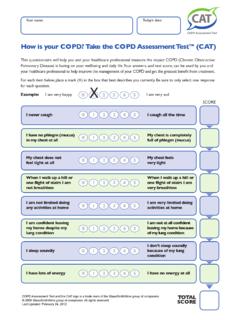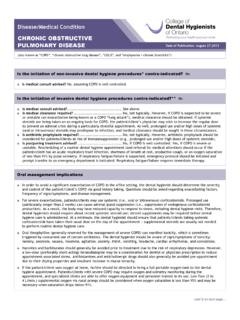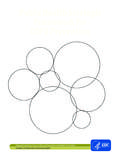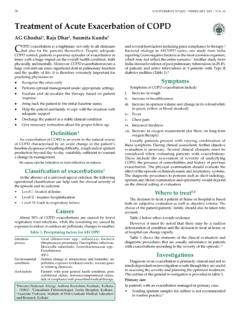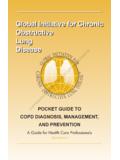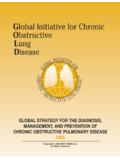Transcription of CLINICAL USE OF PULSE OXIMETRY - COPD-ALERT
1 CLINICAL USE OF PULSE OXIMETRY . POCKET REFERENCE 2010. INTERNATIONAL. Helping the World Breathe Free TM. GLOBAL PRIMARY CARE AND PATIENT EDUCATION. THE PURPOSE OF THIS GUIDE. Chronic respiratory diseases such as copd and asthma are among the most common health conditions seen in primary care practices, affecting more than 1 billion patients worldwide. Primary care clinicians are also often the first point of contact for patients suffering from acute respiratory infections such as influenza and pneumonia. These health care professionals need tools to help them evaluate, monitor, and decide when to refer patients with respiratory conditions. PULSE OXIMETRY is a technology that enables the noninvasive measurement of oxygen saturation, contributing to this measure's rapid acceptance as a fifth vital sign (in addition to temperature, blood pressure, PULSE , and respiratory rate) in CLINICAL assessment.
2 Although the technology has been available since the 1970s, recent advances have reduced the size and cost of PULSE oximeters, and as a result these devices (Figure 1) are becoming increasingly used in respiratory patient monitoring in specialty and primary care practice. In most countries, oximeters are only sold to patients under the guidance of a licensed health care professional, and use by patients should be supervised by their physicians or other qualified health care provider. Incorrect or inappropriate use of oximeters will not provide useful information, and they should be used as part of a broader CLINICAL assessment and not in isolation. Figure 1. PULSE Oximeter Primary care clinicians have varying levels of awareness of PULSE OXIMETRY and knowledge of its proper uses.
3 Therefore, this World Organization of Family Doctors (Wonca) and International copd Coalition (ICC). Oxygen guide offers advice for those who wish to use PULSE Saturation oximeters in patient care. It presents the CLINICAL situations in which the devices are being used and the PULSE Rate scientific evidence for such uses, and it points out the limitations of the devices and inappropriate uses. In addition to scientific articles, we are guided in our recommendations by the expert opinions of the faculty who have overseen the development of this pocket guide. It will be important for clinicians and their patients to monitor the appearance of new published, peer-reviewed CLINICAL research concerning the CLINICAL and home uses of PULSE OXIMETRY . This document was prepared by the Wonca expert panel including Antonio Anzueto, Richard Casaburi, Stephen Holmes, and Tjard Schermer, with Yousser Mohammad, Chair.
4 It was developed in collaboration with the International Primary Care Respiratory Group (IPCRG) and the European Federation of Allergy and Airways Diseases Patients Associations (EFA). The panel members have also solicited input from various experts working in developing countries in order to produce a document that will be relevant to a variety of health care systems and socioeconomic conditions. 1. BACKGROUND AND PRINCIPLES OF PULSE OXIMETRY . PULSE OXIMETRY is a noninvasive method that enables rapid measurement of the oxygen saturation of hemoglobin in arterial blood. [1] It can rapidly detect changes in oxygen saturation, thus providing an early warning of dangerous hypoxemia. [2, 3]. The use of PULSE OXIMETRY for patient assessment and monitoring is well established in critical care, anesthesiology, and emergency departments.
5 [2] In recent years, the availability of small, user-friendly, portable and affordable PULSE oximeters, including those worn on the finger-tip has opened up the potential for use of this technique in an expanded variety of CLINICAL settings, including primary care. [4]. A PULSE oximeter shines light at two wavelengths red and infrared through a part of the body that is relatively translucent and has good arterial pulsed blood flow ( , finger, toe, earlobe) (Figure 2a). The ratio of red to infrared light that passes through the measurement site and is received by the oximeter's detector depends on the percentage of oxygenated versus deoxygenated hemoglobin through which the light passes (Figure 2b). [2] The percentage of oxygen saturation thus calculated is referred to as the percent SpO2.
6 [3]. Figure 2. PULSE Oximeter Function 100. 90. 80 Nonin Percent (0% Contamination). SpO2 70. 60. Other Sensor Mfrs. 3% 2% 1%. 50. Red/Infrared a. A PULSE oximeter noninvasively measures oxygen b. The ratio of red to infrared light yields the saturation by shining light through a digit or earlobe. oxygen saturation, or SpO2. Table 1. Evaluation of SpO2 measurements o An SpO2 of greater than 95% is generally considered to be normal. o An SpO2 of 92% or less (at sea level) suggests hypoxemia. In a patient with acute respiratory illness ( , influenza) or breathing difficulty ( , an asthma attack), an SpO2 of 92% or less may indicate a need for oxygen supplementation. In a patient with stable chronic disease ( , copd ), an SpO2 of 92% or less should prompt referral for further investigation of the need for long-term oxygen therapy [5, 6].
7 PULSE OXIMETRY can be a useful aid to CLINICAL decision-making, but is not a substitute for a CLINICAL assessment nor sufficient for diagnosis by itself. [4] Arterial blood gas measure- ments, obtained by arterial puncture, remain the gold standard for measurement of oxygen saturation. [2] PULSE OXIMETRY is valuable in triaging potentially hypoxic patients in the home, office, and clinic or hospital settings to determine which patients should have arte- rial blood gas measurements. 2. CURRENT CLINICAL USES OF PULSE OXIMETRY . A small but growing body of research, detailed in Table 2, is establishing the usefulness of PULSE OXIMETRY in primary care, particularly but not exclusively for the management of acute and chronic respiratory disease. In patients with copd , PULSE OXIMETRY is useful in stable patients with severe disease (FEV1 < 50% predicted), and in patients with worsening symptoms or other signs of an acute exacerbation, as a tool for patients to use at home to assist with their management under physician guidance.
8 It is important to note that PULSE OXIMETRY complements, rather than competes with, spirometry in the assessment of copd patients. Spirometry remains the gold standard for diagnosing and staging copd , while PULSE OXIMETRY provides a method for rapid assessment especially of short-term respiratory compromise. In patients with asthma , PULSE OXIMETRY complements peak flow meters in assessing the severity of asthma attacks/exacerbations and response to a treatment. In patients with acute respiratory infection, PULSE OXIMETRY is useful in evaluating the severity of the illness and, in conjunction with other criteria, determining whether and how to refer patients for further treatment. Table 2 gives further details about the recommended indications for use of PULSE OXIMETRY in various primary care situations.
9 Recommendations about the use of PULSE OXIMETRY in specific primary care situations have also been incorporated into some guideline documents for respiratory care. [For a summary of recommendations from several such documents, see Ref. 7; also see 6, 8, 9, 10, 11.] Although PULSE oximeters may also have additional applications in certain health care settings, the most common and best- evidenced primary care uses of PULSE oximeters are covered here. LIMITATIONS OF PULSE OXIMETRY . Despite recent technological improvements, PULSE oximeters have some limitations that can affect the accuracy of the measurement. Clinicians should be aware of certain situations where the oximeter reading may not be accurate (Table 3). In addition, some patients with severe chronic lung disease experience hypoxic drive, in which respiration is driven by low oxygen levels rather than elevated carbon dioxide levels.
10 These patients often have severe disease and may already be on long-term oxygen therapy. This condition does not affect the accuracy of PULSE OXIMETRY readings, but it does affect the goals of monitoring and treatment. Specifically, to avoid hypercapnia, for some of these patients the goal should be to maintain SpO2 at a somewhat lower target ( , between 88-92%). [3]. 3. Table 2. Current CLINICAL Uses of PULSE OXIMETRY in Primary Care copd . Stable disease Establishing a baseline value in patients with stable disease. [4]. Monitoring of patients with exercise-related dyspnea. [4]. In patients with moderate to severe copd , a screening tool to identify patients ( , those with SpO2 <. 92%) who should be referred for comprehensive oxygen assessment. [3]. In patients with stable copd or those recovering from an exacerbation at home, an SpO2 88% or less is a strong indication to initiate long-term oxygen therapy.
